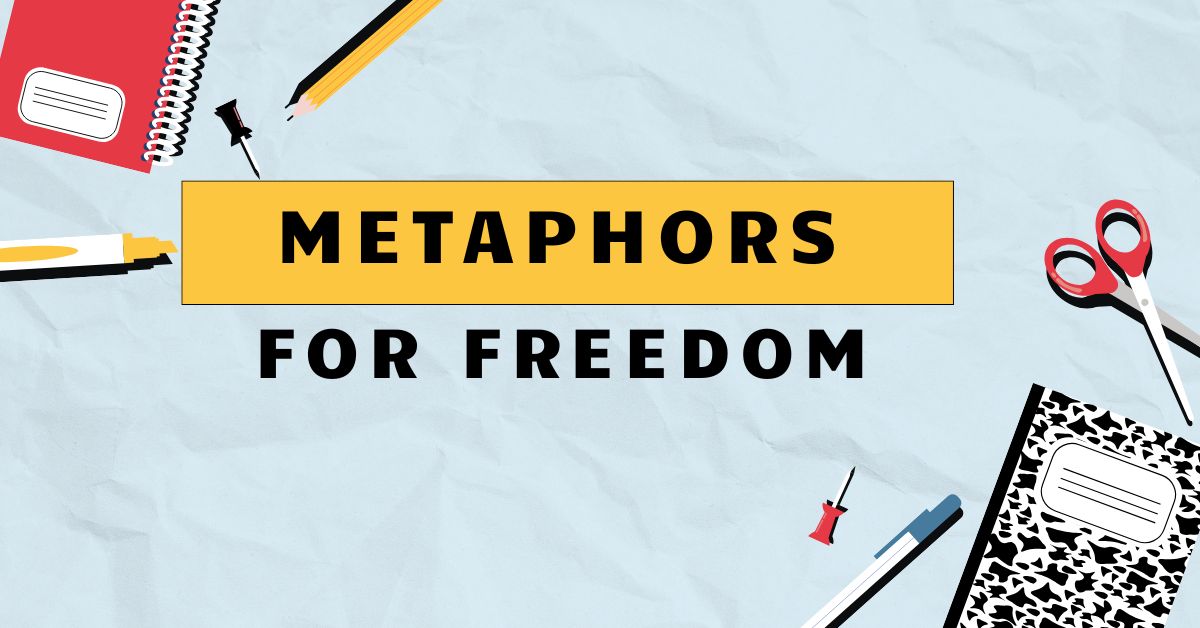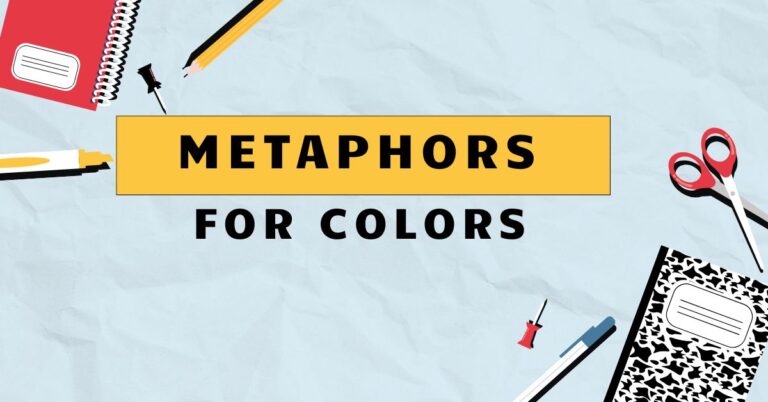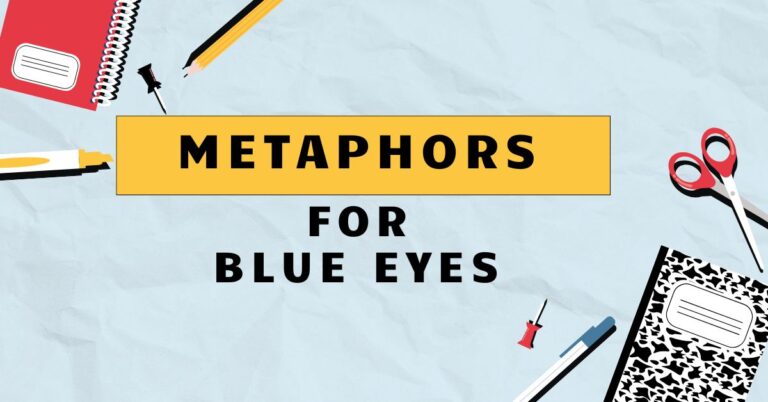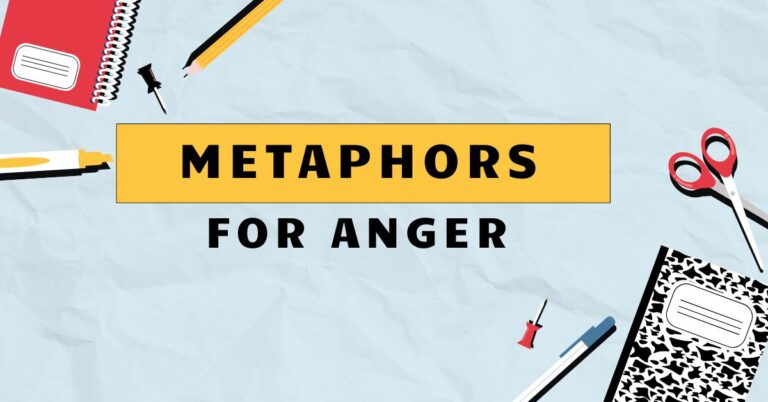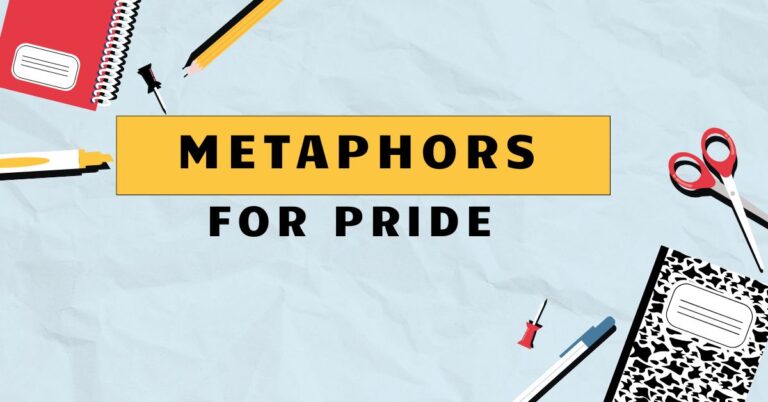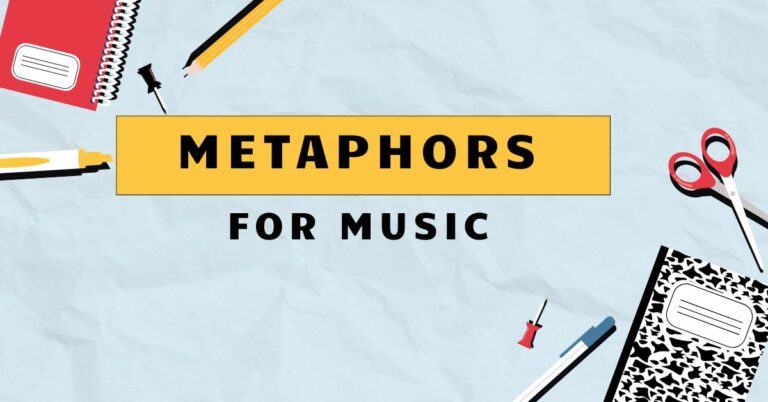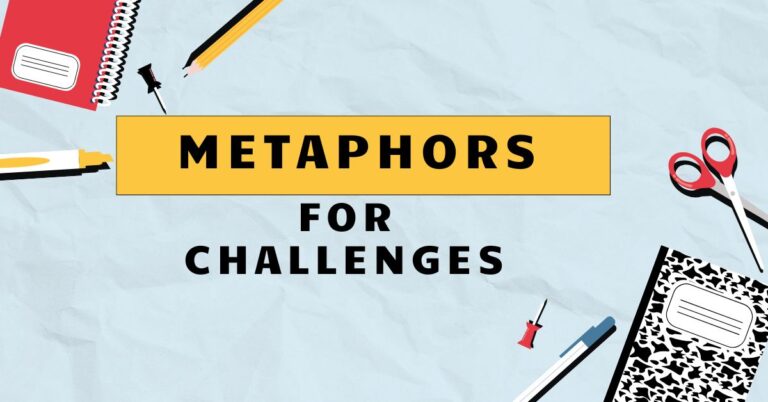29 Metaphors for Freedom: Understanding Figurative Language
Metaphors are powerful tools in the English language, allowing us to express abstract concepts in vivid and relatable ways. Understanding metaphors, especially those related to freedom, enhances our comprehension of literature, speeches, and everyday conversations.
This article delves into the world of metaphors for freedom, exploring their definition, structure, types, and usage. It will benefit students, writers, and anyone interested in improving their understanding and use of figurative language.
Table of Contents
- Introduction
- Definition of Metaphor
- Structural Breakdown of Freedom Metaphors
- Types and Categories of Freedom Metaphors
- Examples of Freedom Metaphors
- Usage Rules for Freedom Metaphors
- Common Mistakes with Freedom Metaphors
- Practice Exercises
- Advanced Topics in Freedom Metaphors
- Frequently Asked Questions
- Conclusion
Definition of Metaphor
Ametaphoris a figure of speech that directly compares two unrelated things, asserting that one thingisanother. Unlike similes, which use “like” or “as” to make a comparison, metaphors create a more direct and implicit connection.
This comparison is not meant to be taken literally but is used to create a deeper understanding or a more vivid image. Metaphors function by transferring qualities or characteristics from one thing to another, allowing the listener or reader to perceive the subject in a new light.
In the context of “freedom,” metaphors often draw parallels between freedom and tangible, easily understood concepts such as birds, open spaces, or light. These comparisons help to convey the essence of freedom – its boundlessness, its uplifting nature, and its inherent value.
Structural Breakdown of Freedom Metaphors
Understanding the structure of a metaphor involves identifying its key components: thetenor(the subject being described) and thevehicle(the object or concept used to describe the subject). In the case of freedom metaphors, the tenor is always freedom itself, while the vehicle can vary widely.
For instance, in the metaphor “Freedom is a soaring eagle,” freedom is the tenor, and a soaring eagle is the vehicle.
The effectiveness of a metaphor depends on the relationship between the tenor and the vehicle. A strong metaphor highlights shared qualities or characteristics, creating a resonant connection in the mind of the audience.
In the example above, the soaring eagle evokes feelings of independence, height, and unobstructed movement, all of which are associated with freedom.
Metaphors can also be extended, meaning that the comparison is developed over several sentences or even an entire paragraph. This allows for a more nuanced and detailed exploration of the relationship between the tenor and the vehicle.
Types and Categories of Freedom Metaphors
Freedom metaphors can be categorized based on the type of vehicle used. Here are some common categories:
Nature-Based Metaphors
These metaphors draw comparisons between freedom and elements of nature, such as open fields, flowing rivers, or the vast sky. They often emphasize the boundless and untamed aspects of freedom.
Animal-Related Metaphors
These metaphors use animals, particularly birds, to represent freedom. The ability to fly, to roam freely, and to live without constraints makes animals powerful symbols of liberty.
Journey-Based Metaphors
These metaphors depict freedom as a journey or a path, often emphasizing the challenges and obstacles involved in achieving and maintaining freedom. They can also highlight the transformative power of freedom.
Light and Darkness Metaphors
These metaphors contrast freedom with oppression, often using light to represent freedom and darkness to represent the lack thereof. They can also explore the idea of freedom as enlightenment or knowledge.
Confinement-Based Metaphors
These metaphors use the concept of being confined, such as in a cage or prison, to illustrate the opposite of freedom. They often highlight the desire for liberation and the struggle against oppressive forces.
Examples of Freedom Metaphors
Here are some examples of freedom metaphors, categorized by type:
Nature-Based Metaphors
The following table presents examples of nature-based metaphors for freedom, illustrating how natural elements can embody the concept of liberty.
| Metaphor | Explanation |
|---|---|
| Freedom is a boundless ocean. | Freedom is vast and limitless, like the ocean. |
| Liberty is a flowing river, carving its own path. | Freedom is dynamic and unstoppable, shaping its own course. |
| Her spirit was a wild meadow, untamed and free. | Her inner self was unrestrained and natural, symbolizing freedom. |
| Freedom is the open sky above us. | Freedom is always present, vast, and unrestricted. |
| His words were like seeds of freedom, scattered across the land. | His message spread liberty and inspired others. |
| The right to choose blossomed like wildflowers in spring. | The freedom to choose flourished beautifully and naturally. |
| Freedom is a mountain peak, challenging to reach but rewarding. | Freedom requires effort but offers great satisfaction. |
| The constitution is the bedrock of our freedom. | The constitution provides a strong, fundamental basis for freedom. |
| Freedom is the wind in our sails, propelling us forward. | Freedom gives us the momentum to progress and achieve our goals. |
| The truth is a forest, where the free can roam and discover. | Truth offers a space for exploration and independent thought. |
| Freedom is the sunlight that nourishes our growth. | Freedom provides the essential conditions for personal and societal development. |
| Her ideas flowed like a waterfall of freedom. | Her innovative thoughts represented a cascade of liberation and change. |
| The fight for equality is a long, winding river towards freedom. | Achieving equality and freedom is a continuous, challenging journey. |
| Freedom is the fertile ground where dreams take root. | Freedom provides the opportunity for aspirations to grow and thrive. |
| His voice echoed through the valley of freedom. | His message resonated deeply within a free environment. |
| The spirit of freedom is an unyielding oak tree. | The essence of freedom is strong, resilient, and enduring. |
| Freedom is the vast desert, empty but full of potential. | Freedom is open and expansive, offering endless possibilities. |
| The island nation stood as a beacon of freedom in a sea of tyranny. | The nation represented a shining example of liberty amidst oppression. |
| Their voices rose like a chorus of birds, singing the song of freedom. | Their collective expression celebrated liberty and unity. |
| Freedom is a seed that grows into a mighty tree of justice. | Freedom, when nurtured, leads to a strong and fair society. |
| The struggle for independence was a wildfire of freedom. | The fight for independence quickly spread and consumed the nation, bringing freedom. |
| Freedom is the air we breathe, essential for life. | Freedom is as vital and necessary to human existence as air. |
| The right to protest is a river of voices flowing towards freedom. | Collective protest and expression work towards achieving greater liberty. |
Bird-Related Metaphors
The following table presents examples of bird-related metaphors for freedom. Birds, with their ability to fly, are often used to symbolize freedom and independence.
| Metaphor | Explanation |
|---|---|
| Freedom is a soaring eagle. | Freedom is powerful and unrestrained. |
| Her dreams took flight, like birds set free from a cage. | Her aspirations were released and allowed to flourish. |
| His spirit was a free bird, flying wherever it pleased. | His inner self was independent and unconstrained. |
| The right to speak freely is the wings of democracy. | Free speech enables democracy to function and thrive. |
| Their hopes for a better future soared like a flock of birds. | Their optimism and expectations rose collectively. |
| She felt like a caged bird, longing for freedom. | She felt trapped and yearned for liberation. |
| Freedom is the lark’s song at dawn. | Freedom is a beautiful and uplifting expression. |
| His ideas were like migrating birds, spreading to new lands. | His thoughts and concepts traveled far and wide. |
| The protesters were a flock of pigeons, pecking at the statue of oppression. | The demonstrators were persistent in their fight against injustice. |
| Freedom is the albatross that guides us through stormy seas. | Freedom leads us through difficult times. |
| Like a phoenix, freedom rises from the ashes of oppression. | Freedom is resilient and can be reborn after periods of suppression. |
| The pursuit of liberty is a hawk’s relentless hunt. | Seeking freedom requires determination and focus. |
| The free press is the watchful owl of democracy. | A free media keeps a vigilant eye on the government and society. |
| Freedom is the hummingbird, sipping nectar from every flower. | Freedom allows one to experience and enjoy life to the fullest. |
| His words were like the raven’s call, a stark reminder of lost freedom. | His message served as a somber warning about the absence of liberty. |
| The new law gave the people wings to fly towards prosperity. | The legislation empowered individuals to achieve success and well-being. |
| Freedom is the swan, gliding gracefully on the lake of opportunity. | Freedom enables smooth and elegant progress in favorable circumstances. |
| The artist’s creativity was a falcon, diving into the depths of imagination. | The artist’s imaginative powers were powerful and unrestrained. |
| Freedom is the parrot, echoing the voices of the oppressed. | Freedom amplifies the voices of those who are marginalized and silenced. |
| The activist was a tireless swallow, building a nest of freedom. | The activist diligently worked to create a secure and nurturing environment for liberty. |
| The constitution is the nest that protects the eggs of freedom. | The constitution safeguards the fundamental rights and principles of liberty. |
| His spirit was a robin, chirping joyfully in the branches of freedom. | His inner self expressed happiness and contentment within a free environment. |
| The journalist was a blue jay, fearlessly exposing corruption. | The journalist boldly revealed wrongdoing, contributing to a more transparent and accountable society. |
Journey-Based Metaphors
The following table presents examples of journey-based metaphors for freedom, portraying freedom as a path or a destination.
| Metaphor | Explanation |
|---|---|
| Freedom is a long and winding road. | Freedom requires perseverance and can be challenging. |
| The path to liberty is paved with sacrifice. | Achieving freedom often involves hardship and loss. |
| Their journey towards freedom was fraught with obstacles. | Their pursuit of freedom was filled with difficulties. |
| Freedom is the destination at the end of a difficult climb. | Freedom is a rewarding goal achieved through hard work. |
| The struggle for equality is a marathon, not a sprint. | Achieving equality requires sustained effort over a long period. |
| Each step forward is a victory in the pursuit of freedom. | Every advancement contributes to the ultimate goal of liberty. |
| The road to tyranny is paved with good intentions. | Actions that seem beneficial can sometimes lead to oppression. |
| Freedom is the compass that guides us through the wilderness of uncertainty. | Freedom provides direction and purpose in times of confusion. |
| The march towards justice is a relentless procession. | The pursuit of justice is a continuous and unwavering movement. |
| Freedom is the bridge that connects us to a better future. | Freedom enables progress and improvement in society. |
| The quest for liberty is a voyage across uncharted waters. | Seeking freedom involves exploration and risk-taking. |
| The fight against oppression is a battle fought on many fronts. | Resisting tyranny requires action in various areas. |
| Freedom is the map that leads us to the treasure of self-determination. | Freedom guides us towards the realization of our individual potential. |
| The path to enlightenment is a journey of self-discovery. | Achieving wisdom and understanding involves introspection and personal growth. |
| Freedom is the lighthouse that guides lost ships to safety. | Freedom provides guidance and protection in times of trouble. |
| The struggle for independence is a pilgrimage to the promised land. | Achieving independence is a sacred and transformative journey. |
| Freedom is the train that carries us to the station of opportunity. | Freedom provides the means to reach favorable circumstances. |
| The journey of education is a pathway to intellectual freedom. | Learning and knowledge empower individuals to think critically and independently. |
| Freedom is the mountain pass that leads to a valley of prosperity. | Freedom provides access to success and abundance. |
| The pursuit of truth is a labyrinthine journey. | Seeking truth can be complex and challenging. |
Light and Darkness Metaphors
The following table shows metaphors that use light and darkness to represent freedom versus oppression.
| Metaphor | Explanation |
|---|---|
| Freedom is the light that banishes darkness. | Freedom dispels oppression and ignorance. |
| Oppression is a shadow that stifles freedom. | Oppression restricts and suppresses liberty. |
| The dawn of freedom broke after years of darkness. | Liberty emerged after a long period of oppression. |
| Freedom is a beacon of hope in a world of despair. | Freedom provides inspiration and optimism in difficult times. |
| The flame of liberty must be kept burning brightly. | Freedom must be protected and preserved. |
| His words illuminated the path to freedom. | His message provided clarity and guidance. |
| Ignorance is the darkness that obscures freedom. | Lack of knowledge hinders the understanding and attainment of liberty. |
| Freedom is the radiant sun that warms our souls. | Freedom brings joy and fulfillment to our lives. |
| The chains of oppression cast a long shadow. | The effects of tyranny are widespread and enduring. |
| Freedom is the star that guides us through the night. | Freedom provides direction and hope in times of uncertainty. |
| The light of truth dispels the darkness of lies. | Honesty and transparency overcome deception and falsehood. |
| Freedom is the spark that ignites the fire of revolution. | Freedom inspires action and change. |
Cage Metaphors
The following table illustrates how cages are used to represent the absence of freedom.
| Metaphor | Explanation |
|---|---|
| Society was a gilded cage, beautiful but confining. | Society appeared attractive but restricted individual freedom. |
| The contract was a cage, trapping him in endless debt. | The agreement confined him financially and restricted his choices. |
| Their traditions were a cage, preventing them from evolving. | Their customs restricted their progress and adaptability. |
| He felt like a caged animal, pacing restlessly. | He felt trapped and unable to express his true self. |
| Her mind was a cage, filled with self-doubt and fear. | Her thoughts were limited by negativity and apprehension. |
| The prison walls symbolized the cage of oppression. | The physical barriers represented the lack of freedom and justice. |
| His job was a cage, stifling his creativity. | His work environment restricted his imaginative expression. |
| The old regime was a cage, suffocating the nation’s spirit. | The previous government suppressed the country’s vitality and enthusiasm. |
| The small town was a cage, offering no opportunities for growth. | The limited environment hindered personal and professional development. |
| The abusive relationship was a cage, isolating her from the world. | The harmful connection cut her off from support and independence. |
Usage Rules for Freedom Metaphors
When using metaphors for freedom, it’s important to consider the following rules:
- Clarity: Ensure the connection between freedom and the vehicle is clear and understandable. Avoid obscure or overly complex metaphors.
- Relevance: Choose vehicles that are relevant to the context and audience. A metaphor that resonates with one group may not be effective for another.
- Originality: Strive for originality in your metaphors. Overused metaphors can become clichés and lose their impact.
- Consistency: Maintain consistency in your metaphors. Avoid mixing metaphors that create conflicting images.
- Appropriateness: Use metaphors appropriately for your audience and the tone of your content.
Common Mistakes with Freedom Metaphors
Here are some common mistakes to avoid when using freedom metaphors:
| Incorrect | Correct | Explanation |
|---|---|---|
| Freedom is a concrete wall. | Freedom is an open door. | A concrete wall suggests restriction, while an open door suggests opportunity. |
| Freedom is a heavy chain. | Freedom is a light breeze. | A heavy chain implies burden, while a light breeze implies ease and liberation. |
| Freedom is a dark cave. | Freedom is a shining star. | A dark cave suggests confinement, while a shining star suggests guidance and hope. |
Practice Exercises
Test your understanding of freedom metaphors with these exercises:
Exercise 1: Identifying Metaphors
Identify the metaphor in each sentence:
| Question | Answer |
|---|---|
| 1. Freedom is the air we breathe. | Freedom is the air. |
| 2. His spirit was a free bird. | His spirit was a free bird. |
| 3. The path to liberty is paved with sacrifice. | The path is paved with sacrifice. |
| 4. Oppression is a shadow. | Oppression is a shadow. |
| 5. Her mind was a cage. | Her mind was a cage. |
| 6. Freedom is a long and winding road. | Freedom is a long and winding road. |
| 7. The flame of liberty must be kept burning brightly. | The flame of liberty. |
| 8. The contract was a cage. | The contract was a cage. |
| 9. Freedom is the radiant sun. | Freedom is the radiant sun. |
| 10. Their traditions were a cage. | Their traditions were a cage. |
Exercise 2: Completing Metaphors
Complete the following metaphors:
| Question | Answer |
|---|---|
| 1. Freedom is like a ____. | Freedom is like a soaring eagle. |
| 2. Oppression is a ____ that stifles creativity. | Oppression is a chain that stifles creativity. |
| 3. The fight for freedom is a ____. | The fight for freedom is a marathon. |
| 4. Freedom is the ____ in our sails. | Freedom is the wind in our sails. |
| 5. A mind without freedom is a ____. | A mind without freedom is a locked cage. |
| 6. Freedom is a bridge to ____. | Freedom is a bridge to opportunity. |
| 7. The truth is a ____ that sets us free. | The truth is a key that sets us free. |
| 8. Freedom is a ____ that banishes ignorance. | Freedom is a light that banishes ignorance. |
| 9. The constitution is the bedrock of ____. | The constitution is the bedrock of freedom. |
| 10. Freedom is a journey to ____. | Freedom is a journey to self-discovery. |
Exercise 3: Creating Your Own Metaphors
Create your own metaphors for freedom based on the following prompts:
| Prompt | Example Answer |
|---|---|
| 1. Freedom and nature | Freedom is a vast, unexplored wilderness. |
| 2. Freedom and flight | Freedom is the unrestricted path of a shooting star. |
| 3. Freedom and a journey | Freedom is the last mile of a long pilgrimage. |
| 4. Lack of freedom and darkness | Oppression is a thick fog that blinds the soul. |
| 5. Lack of freedom and confinement | Oppression is a deep well with no rope to climb out. |
| 6. Freedom and potential | Freedom is a blank canvas, waiting for the masterpiece of life. |
| 7. Freedom and growth | Freedom is the sunlight that nourishes the seeds of progress. |
| 8. Freedom and expression | Freedom is a symphony of voices, each unique and powerful. |
| 9. Freedom and resilience | Freedom is a phoenix, rising from the ashes of injustice. |
| 10. Freedom and hope | Freedom is a guiding star in the darkest night. |
Advanced Topics in Freedom Metaphors
For advanced learners, consider exploring the following topics:
- Historical context: How have metaphors for freedom evolved over time in response to different social and political movements?
- Cultural variations: How do metaphors for freedom differ across cultures and languages?
- Subverted metaphors: How can metaphors for freedom be used ironically or satirically to critique existing power structures?
- Extended metaphors: How can a single metaphor for freedom be developed and sustained throughout an entire text?
Frequently Asked Questions
- What is the difference between a metaphor and a simile?
A metaphor directly compares two unlike things by stating that one is the other, while a simile uses “like” or “as” to make a comparison. For example, “Freedom is a bird” (metaphor) versus “Freedom is like a bird” (simile).
- Why are metaphors important in language?
Metaphors add depth and richness to language, allowing us to express abstract concepts in more concrete and relatable ways. They can also evoke emotions, create vivid images, and enhance understanding.
- How can I improve my use of metaphors?
Read widely, pay attention to the metaphors used by others, and practice creating your own. Consider the context, audience, and desired effect when choosing your metaphors.
- What makes a metaphor effective?
An effective metaphor is clear, relevant, original, and consistent. It should create a strong connection between the tenor and the vehicle, and it should resonate with the audience.
- Can a metaphor be overused?
Yes, metaphors can become clichés if they are used too frequently. Overused metaphors lose their impact and can make your writing sound unoriginal. Try to find fresh and creative ways to express your ideas.
- How do cultural differences affect understanding metaphors?
Cultural backgrounds significantly influence the interpretation of metaphors because symbols and associations vary across cultures. A metaphor that resonates in one culture might be confusing or even offensive in another. Therefore, consider your audience’s cultural context when using metaphors.
- Are there any specific types of metaphors that are particularly effective for discussing freedom?
Nature-based metaphors, such as comparing freedom to a vast ocean or a soaring bird, are often effective because they evoke feelings of boundlessness, independence, and natural beauty. Journey-based metaphors can also be powerful, highlighting the challenges and rewards of pursuing freedom. Light versus darkness metaphors are also useful.
- How can I avoid mixing metaphors when writing about freedom?
To avoid mixing metaphors, maintain a consistent image or theme throughout your writing. For instance, if you start by comparing freedom to a bird, continue using related imagery such as wings, flight, or open skies. Avoid introducing unrelated metaphors that create conflicting images, such as comparing freedom to a heavy chain or a dark cave.
- What role do metaphors play in political discourse about freedom?
Metaphors are crucial in political discourse as they shape public perception and understanding of complex issues like freedom. Politicians often use metaphors to frame their arguments, evoke emotions, and persuade audiences. For example, a politician might describe freedom as a “fragile flower” to emphasize the need for protection, or as a “beacon of hope” to inspire optimism.
- How do metaphors of freedom change depending on the historical context?
Metaphors of freedom evolve with historical and social changes. During times of war or oppression, metaphors may focus on liberation from physical bonds, whereas in more peaceful times, they may emphasize intellectual or economic freedom. Examining historical texts reveals how metaphors adapt to reflect contemporary struggles and aspirations.
- What are some examples of metaphors used to describe economic freedom?
Economic freedom is often described using metaphors related to open markets, entrepreneurship, and opportunity. Examples include “a level playing field,” “the engine of prosperity,” and “a ladder to success.” These metaphors highlight the idea that economic freedom provides individuals with the chance to improve their lives through hard work and innovation.
Conclusion
Metaphors are essential for conveying the multifaceted concept of freedom in a vivid and engaging manner. By understanding the structure, types, and usage rules of freedom metaphors, you can enhance your communication skills and deepen your appreciation for figurative language.
Remember to practice creating your own metaphors and to be mindful of the context and audience when using them. Keep exploring the rich world of metaphors, and you’ll discover new ways to express complex ideas with clarity and creativity.

